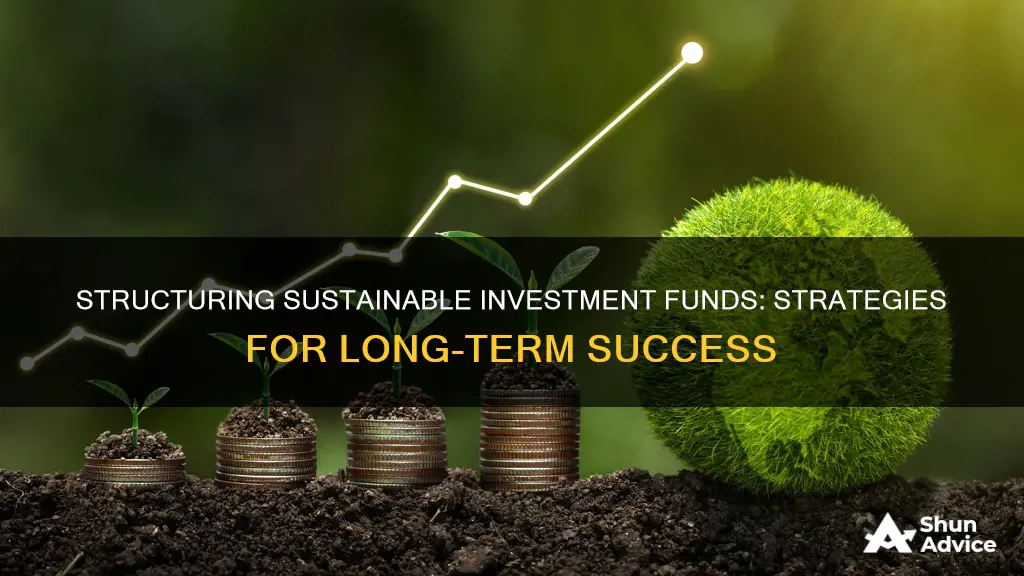
Sustainable investing is an increasingly popular approach to investment that prioritises social and environmental value alongside financial returns. Sustainable investment funds are graded using ESG (environmental, social and governance) principles, and they invest in companies that aim to have a positive societal impact. This might include companies with a small carbon footprint, or diverse leadership boards, for example.
There are several strategies that investors can use to build sustainable investment portfolios, including activist investing, impact investing, and negative/exclusionary screening.
This introduction will explore the different ways to structure a sustainable investment fund, the benefits and challenges of these approaches, and how they are shaping the future of investment.
What You'll Learn

Environmental, social and corporate governance (ESG) criteria
Environmental, social, and corporate governance (ESG) criteria are a set of standards used by sustainable investment funds to evaluate and direct investment capital towards companies that demonstrate a commitment to combating climate change, environmental destruction, and promoting corporate responsibility. The following paragraphs will discuss the key considerations and strategies for structuring a sustainable investment fund around ESG criteria.
Environmental Criteria
The "environmental" aspect of ESG evaluates a company's impact on the natural world, including its carbon footprint, waste production, water usage, and conservation efforts. It also assesses the clean technologies employed and created within its supply chain. Sustainable investment funds favour companies that actively reduce their environmental impact, such as through the use of renewable energy sources or the development of innovative solutions to combat air and water pollution.
Social Criteria
The "social" aspect of ESG focuses on a company's impact on society and its commitment to social good and change. This includes an analysis of the company's stance and involvement in social issues such as human rights, racial diversity and inclusion in hiring practices, employee health and safety, and community engagement. Funds that incorporate social criteria may favour companies that support human rights initiatives or promote ethical corporate cultures.
Governance Criteria
The "governance" aspect of ESG examines how a company is managed or "governed" to drive positive change. This includes evaluating the quality and diversity of its management board and executive team, executive compensation, shareholder rights, transparency and disclosure, anti-corruption measures, and corporate political contributions. Good governance practices ensure that companies are held accountable and are aligned with the interests of their stakeholders, including investors, employees, and the communities they operate in.
Strategies for Incorporating ESG Criteria
Sustainable investment funds can employ various strategies to incorporate ESG criteria into their investment decisions. One common approach is negative or exclusionary screening, where specific sectors, companies, or practices that do not meet ESG standards are excluded from the fund's portfolio. Conversely, positive or best-in-class screening involves actively seeking out and investing in companies that demonstrate strong ESG performance relative to their industry peers.
Another strategy is impact investing, which involves targeted investments aimed at solving social or environmental problems. This can include community investing, where capital is directed towards underserved communities, or financing businesses with clear social or environmental purposes. Activist investing is another approach, where investors buy equity in a company to influence and drive change in its operations, based on moral values or causes that the company may support.
Performance and Sustainability
When structuring a sustainable investment fund, it is important to consider both financial performance and sustainability. While the primary goal of any investment fund is to generate returns, sustainable investment funds aim to balance this with creating long-term environmental and social value. Studies have shown that incorporating ESG criteria does not sacrifice financial performance and can even lead to stronger long-term financial returns. Additionally, sustainable funds have been found to have lower downside risks and greater stability during periods of market volatility.
Monitoring and Reporting
Finally, it is crucial for sustainable investment funds to implement robust monitoring and reporting practices. This includes regularly evaluating the ESG performance of the companies in their portfolios and making adjustments when companies fail to meet sustainability standards. Many funds release impact reports that detail their environmental, social, and governance impacts, providing transparency to investors and allowing them to make informed decisions.
Smart Mutual Fund Investments: 5K and Beyond
You may want to see also

Community investing
One key aspect of community investing is the involvement of credit unions and community development banks. These organisations have a specific mission to serve low- and middle-income communities, offering financial products and services that cater to their unique needs. They provide access to banking, loans, and other financial tools that might not otherwise be available to these communities.
Additionally, community investing can take the form of community development loan funds, which are often supported by foundations or other institutions. These funds are designed to provide financial support for initiatives that have a significant social impact, such as affordable housing projects, small business development, or community infrastructure improvements.
By participating in community investing, investors contribute to the advancement of social and environmental practices while also seeking competitive financial returns. This approach aligns with the broader goals of sustainable investing, which seeks to create long-term value without compromising the well-being of future generations.
A Beginner's Guide to Index Funds in South Africa
You may want to see also

Shareholder resolutions
From 2020 through the first half of 2022, 154 institutional investors and 70 investment managers, collectively controlling a total of $3 trillion in assets, filed or co-filed shareholder resolutions on ESG issues. The leading issue raised in shareholder proposals during this period was ensuring fair workplace practices, particularly regarding ending discrimination based on ethnicity and sex. Investors also focused on the disclosure and management of corporate political spending and lobbying, with shareholders filing 288 proposals on this subject. Many of the targets were companies that supported trade associations opposing regulations to curb greenhouse gas emissions.
In addition to filing or co-filing shareholder resolutions, investors can actively vote their proxies, engage in dialogue with corporate management, or join shareholder coalitions to encourage companies to improve their ESG practices. They can also participate in public policy initiatives, work with government regulatory agencies, and testify and report on ESG investment issues to Congress.
First-Time Funds: Why You Should Invest Now
You may want to see also

Impact investing
The term "impact investing" was first coined in 2007 by the Rockefeller Foundation. Impact investments are made with the intention to generate positive, measurable social and/or environmental impacts, alongside a financial return. These investments can be made in both emerging and developed markets, targeting returns ranging from below market to market rate, depending on investors' strategic goals.
The practice of impact investing is defined by the following elements:
- The intention to have a positive social and/or environmental impact
- Return expectations, ranging from below market to risk-adjusted market rate
- A commitment to measuring and reporting the social and/or environmental performance and progress of underlying investments, ensuring transparency and accountability
Types of Impact Investments
Impact investments come in various forms, including stocks, bonds, mutual funds, or microloans. They span several industries, with a particular focus on clean and renewable energy, environmental practices, and social governance.
Who is Impact Investing for?
Benefits of Impact Investing
- It promotes and encourages corporate practices that are important to investors, such as fair labour practices or environmental stewardship.
- It allows investors to use their resources beyond charitable donations to support issues they care about.
- It supports approaches to addressing societal issues that are sustainable and not fully reliant on philanthropic funds.
- It can generate financial returns, with studies showing that impact investments have met or exceeded the performance of traditional investments.
ESG Funds: Smart Investment, Sustainable Future
You may want to see also

Sustainable fund performance
A study by the Morgan Stanley Institute for Sustainable Investing analysed the performance of ESG-focused mutual funds and ETFs, finding no financial trade-off in returns compared to traditional funds. This was supported by a 2019 study of 11,000 mutual funds, which showed that sustainable funds had similar or better returns and significantly lower downside risks. Additionally, during periods of market volatility, sustainable funds proved to be more stable investments.
When choosing sustainable funds, it is essential to consider both performance and sustainability. Diversified funds are generally recommended over concentrated funds, as they tend to have market-level risk and can help investors stay invested through market ups and downs. It is also important to regularly monitor the funds to ensure they continue to meet performance and sustainability standards.
Sustainable funds can be found through resources like the U.S. Forum for Sustainable Investing (USSIF) list, brokerages, robo-advisors, and ESG financial advisors. However, some funds may have high minimum investment requirements or load fees, so it is essential to consider these factors when selecting a sustainable fund.
By investing in sustainable funds, individuals can align their investments with their values and promote positive social and environmental change without sacrificing financial returns.
Fund Setter: Minimum Investment Requirements and More
You may want to see also
Frequently asked questions
Sustainable investment funds balance traditional investing with environmental, social, and governance-related (ESG) insights to improve long-term outcomes. Sustainable investment funds are additive to asset management theory and consider diverse stakeholders.
Sustainable investors can use a variety of strategies, including negative/exclusionary screening, positive/best-in-class screening, activist investing, and impact investing. Negative/exclusionary screening involves excluding specific sectors, companies, or practices from a fund or portfolio based on ESG criteria. Positive/best-in-class screening involves investing in sectors, companies, or projects with strong ESG performance compared to industry peers. Activist investing involves buying equity in a company to change how it operates, based on moral values. Impact investing involves targeted investments aimed at solving social or environmental problems, such as community investing.
It's important to do your research when selecting sustainable investments. Many analysts and organizations publish annual "best of" lists for top-rated ESG stocks, and you can also find ESG-centric funds from brokerages by searching for "ESG" in their screening tools. You can also consider working with a financial advisor or robo-advisor that specializes in sustainable investing and can help you build a portfolio that aligns with your values and financial goals.







